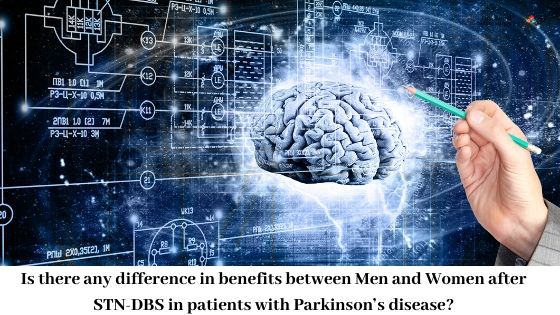Know about difference in benefits between Men and Women after STN-DBS in patients with Parkinson’s disease?
Deep brain stimulation (DBS) is an established method of non-destructive surgical treatment in patients with advanced Parkinson’s disease.
In this method, a battery-operated neurostimulator is implanted into the targeted region (Subthalamic nucleus) of the brain which stimulates it with electrical impulses.
It significantly improves motor, cognitive and mental function as well as physical health-related quality of life in those patients.
It stood the test of time & has become an effective & accepted method of treatment for the disabling motor symptoms as well as complications associated with prolonged treatment with dopaminergic & dopamine agonist drugs in advanced Parkinson’s disease.
But is there any difference in improvement in those parameters between men and women with Parkinson’s disease after Subthalamic nucleus deep brain stimulation (STN-DBS)?
It has already been proved from the epidemiological data that sex-related differences do exist in Parkinson’s disease as males are more susceptible to the disease than females.
Women with Parkinson’s disease have a milder form of the disease in the early phase but they suffer from a higher degree of levodopa-related motor complications in the form of motor fluctuations & dyskinesia.
This is related to poorly understood factors e.g. different structural & functional dopaminergic brain pathways as well as genetic influences along with lifestyle exposures, hormonal and reproductive factors.
In advanced Parkinson’s disease, STN-DBS is known to improve motor function as well as non-motor symptoms.
Patients also need a lower dose of levodopa & dopaminergic drugs following STN-DBS. The improvement in motor function & non-motor symptoms are similar in men & women is proved by several short-term studies.
But there is a difference in health-related quality of life as well as long term benefits following deep brain stimulation in males & females as per the recent Korean study.
The Korean study was conducted at the Movement Disorder Centre of Seoul National University Hospital (SNUH) by a team of scientists to know the disparity in long term outcomes between the two sexes after STN-DBS.
The study consisted of 48 male & 52 female PD patients. Baseline assessment of motor, cognitive, mental function & health-related quality of life, were done in all patients at the starting of the treatment from off- and on medication, states & postoperatively from both the off medication / on-stimulation and on-medication/on-stimulation states.
Follow up evaluations were done at 1yr & 5yrs. Unified Parkinson’s Disease Rating Scale (UPDRS) tool was used to assess the motor symptoms.
Health-related quality of life assessment was done using the 36-Item Short-Form Health Survey (SF-36) which includes improvement in physical functioning, bodily pain & general health.
The analysis of retrospectively collected data showed similar short term & long-term effects of STN-DBS on motor, cognitive & depressive symptoms in males & females.
However, improvements in physical health-related quality of life following STN-DBS little bit greater in men than women which are more so in long term observation which is statistically significant as per the researchers.
This can be explained by the fact that female PD patients suffer more frequently from musculoskeletal problems as well as they suffer from a more severe form of PD than males.
Moreover, the females are more susceptible to emotional distress which also counts towards the negative influence on the physical health-related quality of life.
To conclude STN-DBS results in a similar kind of short term & long term effects on motor function, cognitive & depressive symptoms and functional status between men & women PD patients but improvement in the physical health-related quality of life is more in males to a greater extent compared to females on long term follow up as per the researchers.
They have also of the opinion that further studies are required to ascertain the exact mechanism behind the sex-associated differences & to formulate a better strategy to improve the physical health-related quality of life in females following Subthalamic nucleus deep brain stimulation.
Author Bio:
Dr. Deepak Das, who is an expert in Skull base neurosurgery in Odisha. Now, pursuing a fellowship in Functional & Stereotactic Neurosurgery. He is a writer in different neurosurgical journals.





